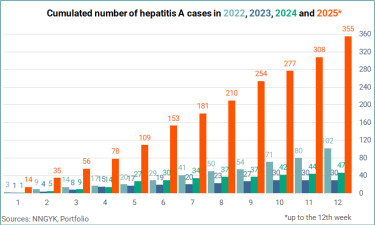Hungary has 7.5 times more hepatitis A cases than a year ago
According to the statement, the disease, which is caused by the hepatitis A virus, is
rare in developed countries and is a childhood disease in developing countries, with almost everyone contracting the disease by adulthood.
The virus is spread through contaminated faeces, contaminated water, ice and food. In rare cases, it can also be transmitted sexually. Infection is most common in places with poor hygiene and where there is a lack of water purification and an inadequate supply of fresh water.
The hepatitis A vaccine is recommended for people in high-risk groups and can be obtained from pharmacies on prescription for a fee.
People at increased risk include those who travel to infected subtropical or tropical countries, live in or travel to places with poor sanitation (e.g. pit latrines or no running water), or have an underlying medical condition (e.g. haemophiliacs, chronic carriers of hepatitis B or C viruses).
They also include people at increased risk of hepatitis A infection due to their lifestyle (e.g. intravenous drug users, MSM ( men who have sex with men) population), the release said.
The first graph below shows the cumulative number of weekly hepatitis A cases since 2017. We think it is pretty straightforward and does not need much of an explanation. We're up at 355 cases, compared to just 47 a year ago and 124 in 2017, which was the worst year until now (that's as far back as publicly available NNGYK data go).

The two graphs below show the actual weekly figures and the cumulative number of hepatitis A cases over the last four years, and both clearly show how much this year stands out in terms of infections.


In the same report, the NNGYK also released the number of suspected pertussis cases for the 12th week, showing a drop to 6 from 12 cases on the 11th week. Abou 29% of the infections were in infants, 45.8% were in children up to 14 years of age, 52.4% were in children up to 19 years of age, and more than 13% of the infections were in people over 60 years of age.











